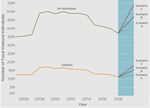The Impact of the Coronavirus on Child Food Insecurity
←
→
Page content transcription
If your browser does not render page correctly, please read the page content below
The Impact of the Coronavirus
on Child Food Insecurity
April 22, 2020 | For questions or information, contact research@feedingamerica.org.
KEY FINDINGS
• Households with children are more likely to be food insecure. In
2018, 11.2 million children (1 in 7), lived in a food-insecure
household.
• As closures caused by the coronavirus lead to a rise in
unemployment and poverty, more people will experience food
insecurity.
• A significant rise in unemployment over the year (+7.6 percentage
points) and a corresponding rise in child poverty (+5.0 percentage
points) would result in a total of 18.0 million children (1 in 4)
experiencing food insecurity.
INTRODUCTION
As closures and social distancing orders meant to limit spread of the
novel coronavirus (COVID-19) extend across the country, the impact is
being felt in communities large and small. While changes taking place
are disrupting the lives of nearly everyone in some way, food-insecure
individuals – who numbered over 37 million (11.5%), including over 11
million children, in 20181 – will face particular challenges. With
unemployment soaring - approximately 22 million workers filed for
unemployment benefits within the last four weeks2 – the number of
people who experience food insecurity is likely already increasing.
1 Coleman-Jensen, A., et al. (2019). Household Food Security in the United States in 2018. U.S. Department of
Agriculture Economic Research Service.
2 Department of Labor. (2020, April 16). Unemployment Insurance Weekly Claims [Press Release]. Retrieved
from https://www.dol.gov/sites/dolgov/files/OPA/newsreleases/ui-claims/20200632.pdf2 ESTIMATING THE INCREASE IN NEED Feeding America’s Map the Meal Gap study can be used to predict changes in food insecurity based on projected annual changes to unemployment and poverty. An earlier brief entitled The Impact of the Coronavirus on Food Insecurity focused on projections for food insecurity for the overall population. Those analyses have been expanded here to include a separate look at food insecurity among children.3 Prior to the current crisis and for as long as food insecurity has been measured, households with children are more likely to be food insecure.4 For more information pre-coronavirus, see the Map the Meal Gap report on child food insecurity here. The tables in this brief display three potential scenarios, depicting increasing severity of changes to annual poverty and unemployment rates and the changes to food insecurity for children that may result. Scenarios A and B represent the same changes to poverty and unemployment that occurred during the Great Recession after one year and two years, respectively, while Scenario C portrays a more severe picture. Table 1 displays the underlying assumptions around annual changes to unemployment and poverty and the food insecurity rate increase that would result. For example, in Scenario C, if unemployment increases by 7.6 percentage points in 2020 from its base in 2018 (from 3.9% to 11.5%) and child poverty increases by 5.0 percentage points (from 16.2% to 21.2%), child food insecurity would increase by 9.3 percentage points (from 15.2% to 24.5%). This would be an unprecedented increase in food insecurity among children and would be the highest level since food insecurity began being measured in 1996. 3 For the purposes of this brief, the term “child food insecurity” is used to indicate children living in food insecure households which is consistent with how it is used in Map the Meal Gap and in, for example, Table 1B in Coleman-Jensen et al. (2019). 4 Coleman-Jensen, A., et al. (2019). Household Food Security in the United States in 2018. U.S. Department of Agriculture Economic Research Service.
3
Table 1: Projected unemployment, child poverty and child food insecurity
rate changes by scenario
Scenario Scenario Scenario
Impact on key variables
A B C
Increase to unemployment rate (% pts) 1.1 4.5 7.6
Increase to child poverty rate (% pts) 1.6 3.9 5.0
increase in child food insecurity rate (% pts) 1.6 5.8 9.3
Source: calculations by Dr. Craig Gundersen.
Note: The percentage point changes are relative to 2018 base rates of 3.9% unemployment, 16.2% child poverty, and 15.2% child food
insecurity.
As seen in Table 2, under these three scenarios, the indicated
increases would result in a total of between 12.4 million and 18.0
million children living in food-insecure households. Already, one in
seven children in the U.S. is food insecure. Under Scenario C, that
number would jump to one in four.
It is important to note that individuals and households with different
characteristics experience food insecurity at different rates. For
example, households are more likely to be food insecure if there are
members of a minority race/ethnicity, specifically African American,
Latino and American Indian. Households headed by a single parent
experience food insecurity at significantly higher rates, especially
when the head is female, as do households where a child or parent is
disabled.5.6
Table 2: Projected changes to child food insecurity by scenario
Food insecurity projections Scenario A Scenario B Scenario C
Child food insecurity rate, pre- 15.2% 15.2% 15.2%
COVID-19 (2018) (1 in 7) (1 in 7) (1 in 7)
Projected increase to child food
11% 38% 61%
insecurity rate (%)
16.8% 21.0% 24.5%
Projected child food insecurity rate
(1 in 6) (1 in 5) (1 in 4)
Food-insecure children, pre-COVID-
11.2 M 11.2 M 11.2 M
19 (2018)
Projected increase to number of
1.2 M 4.2 M 6.8 M
food-insecure children
Projected number of food-insecure
12.4 M 15.4 M 18.0 M
children
Source: Pre-COVID-19 rates and numbers are taken from Household Food Security in the United States in 2018. All other figures are
based upon calculations by Dr. Craig Gundersen.
5 Coleman-Jensen, A., et al. (2019). Household Food Security in the United States in 2018. U.S. Department
of Agriculture Economic Research Service.
6 Coleman-Jensen A., & Nord, M. (2013). Food Insecurity among Households with Working-Age Adults with
Disabilities. U.S. Department of Agriculture, Economic Research Service: Washington, D.C.4
Ultimately, the impact of the coronavirus crisis on food insecurity will
depend on the speed with which transmission of the virus can be
controlled and closures and social distancing orders are relaxed. The
longer that the shutdown goes on, the more likely it is that high levels
of unemployment will persist, and more people will face food
insecurity.
Figure 1 displays food insecurity numbers for the three scenarios
alongside historic trends for children and for all individuals. As noted
previously, Scenarios A and B reflect the same changes to poverty
and unemployment rates that occurred during the Great Recession,
which has been a common point of comparison for the currently
unfolding crisis. However, the current recession has moved with much
greater speed than the last, and many experts are predicting larger
increases to unemployment rates than seen during the Great
Recession.7 Scenario C would involve significant increases to both
unemployment and poverty that would result in food insecurity
reaching the highest rate and number in the 25 years it has been
measured.
Figure 1. Food Insecurity Trends and Projections, All individuals and Children
Source: Pre-COVID-19 numbers are taken from Household Food Security in the United States in 2018.
All other figures are based upon calculations by Dr. Craig Gundersen.
7 WSJ Survey: Coronavirus to Cause Deep U.S. Contraction, 13% Unemployment. (2020, April 8). Wall Street Journal.
Retrieved from https://www.wsj.com/articles/wsj-survey-coronavirus-to-cause-deep-u-s-contraction-13-unemployment-
115863544005 THE GOVERNMENT RESPONSE There have been a number of proposals for federal, state, and local responses to the COVID-19 crisis that will aim to bolster the economy and provide direct support to those who have been most affected. These responses have the potential to mitigate the depth and breadth of hardship that could otherwise result. Federal nutrition programs, especially the Supplemental Nutrition Assistance Program (SNAP), continue to be an important first line of defense against food insecurity for millions of people and will become particularly critical during this period of acute need. Policies responding to this crisis have included additional federal food purchases and SNAP benefits for some families as well as flexibility in program operations to adjust to changing local environments as local SNAP offices and schools close and individuals are limited in their mobility.8 As social distancing efforts continue, more states have been approved to provide online purchasing of food to SNAP Households through approved retailers.9 Unique to the current crisis, schools are closed in most parts of the country, which has disrupted not only learning but access to meals that are typically provided during the school day.10 In response to these closures, a new program called Pandemic-EBT (P- EBT) has been created, which gives money to families whose children would have otherwise received free or reduced-price school meals to replace the value of those meals. States must choose to operate this new program and submit a plan to USDA for approval. This will be provided on an electronic benefits transfer (EBT) card and is available to families in areas where school are closed for at least five consecutive days.11 8 For information visit https://www.feedingamericaaction.org/learn/legislation/. 9 Food and Nutrition Service. (2020, April 6). FNS Launches the Online Purchasing Pilot. Retrieved from https://www.fns.usda.gov/snap/online-purchasing-pilot 10 Map: Coronavirus and School Closures. (2020, April 7). Retrieved from https://www.edweek.org/ew/section/multimedia/map-coronavirus-and-school-closures.html 11 Feeding America has provided a checklist and information on nationwide and state waivers here: https://www.feedingamericaaction.org/wp-content/uploads/2020/04/Child-Nutrition-Covid-19-Checklist-and-Information.pdf
6
FEEDING AMERICA’S RESPONSE
While swift federal action to increase investment in federal programs
including SNAP will be key to help individuals weather the current
crisis, many are turning to charitable food assistance in an effort to
make ends meet. In and out of times of crisis, charitable programs
can help supplement the food budgets for federal program recipients,
while for households with incomes that exceed federal program
eligibility limits, charitable programs may be the only option.
Feeding America and its 200 member food banks are working in
communities across the country in response to the COVID-19 crisis,
adapting service models to minimize risk of transmission while
helping those in need. In this time of uncertainty, the Feeding
America network is working to ensure that this pandemic does not
perpetuate inequity or deepen the burdens often borne
disproportionately by at-risk populations and low-income people. One
such at-risk group is children, and there are several ways food banks
are addressing child food insecurity specifically during this time.
Some food banks are working with school districts to implement
drive-thru food distributions at schools that are closed. Others have
converted existing School Pantry and BackPack programs, and are
now distributing to-go meals to kids and families. Others still are
working with community partners to activate summer and after-
school sites to distribute meals to children.
Prior to the COVID-19 pandemic, the Feeding America network
served over 40 million people each year, many of whom will
experience more severe levels of need in the coming months. The
sharp decline in the economy is also leading to an increase in the
number of new individuals – both adults and children – experiencing
or at heightened risk of food insecurity. Food banks are already
reporting increased demand, while facing operational challenges,
including declines in volunteers and food donations. The high demand
for charitable food assistance is expected to remain at elevated levels
for the foreseeable future.
Contributors: Monica Hake | Emily Engelhard | Adam Dewey | Dr. Craig Gundersen
For questions or information, contact research@feedingamerica.org.You can also read



























































